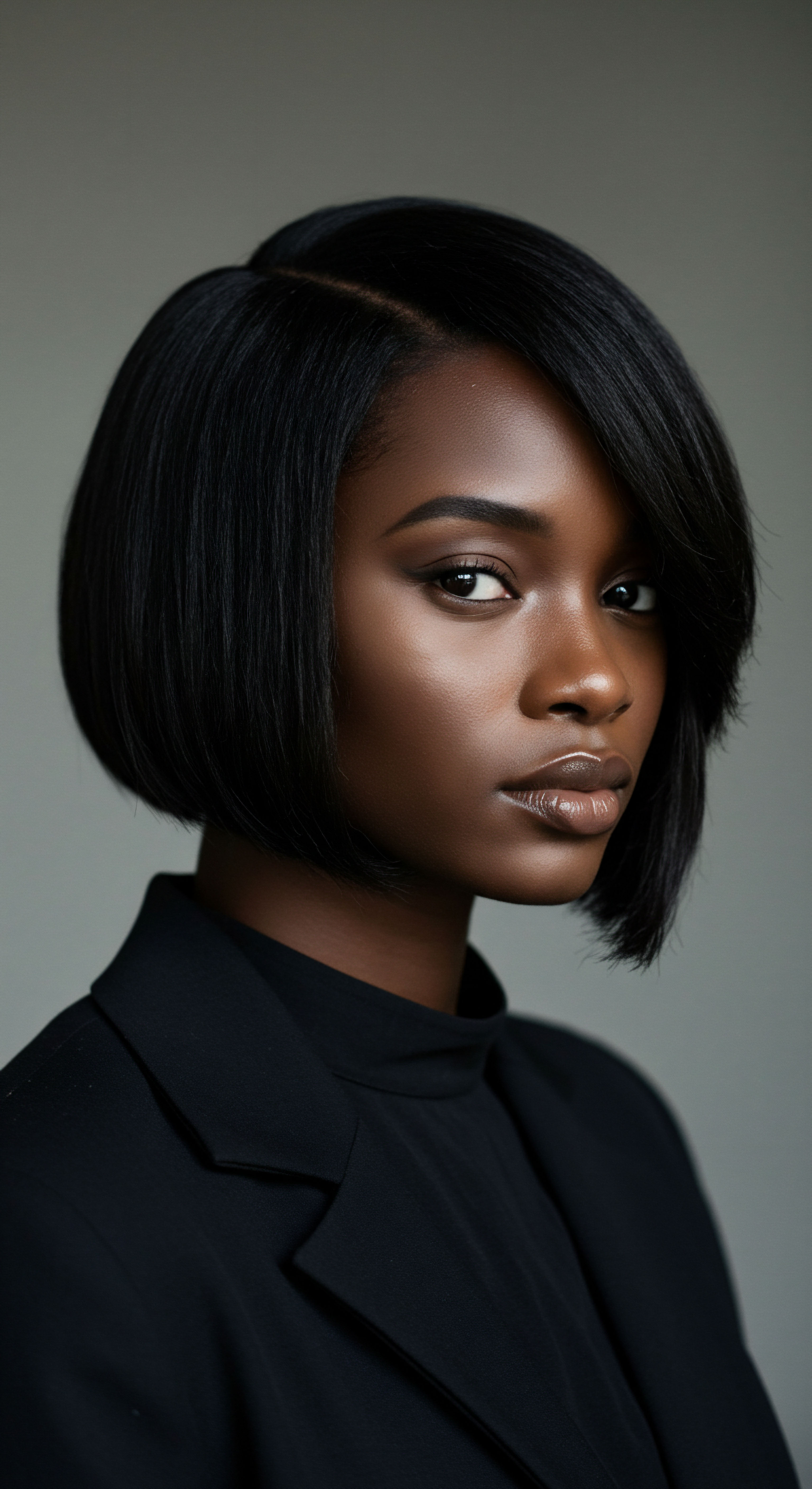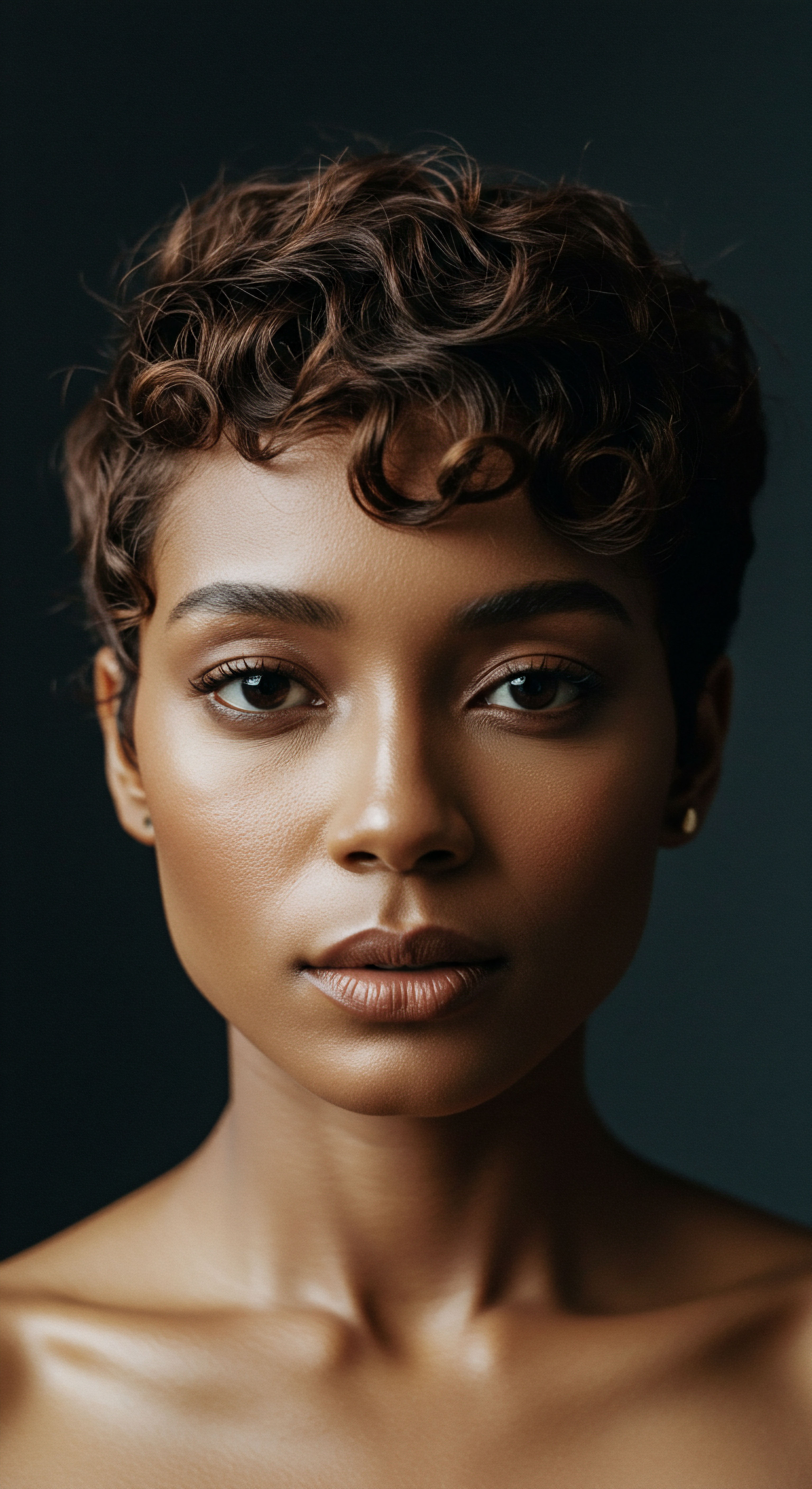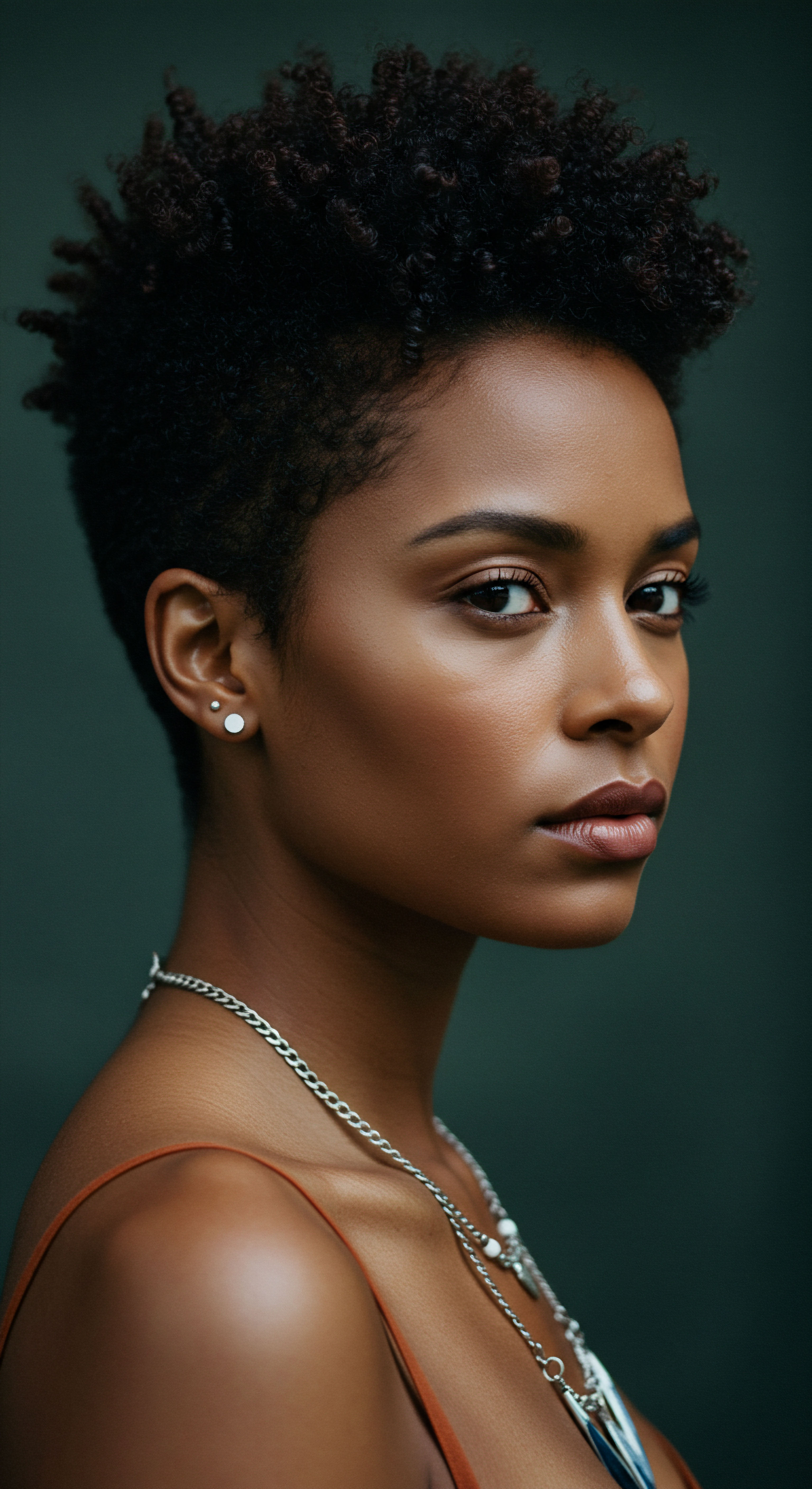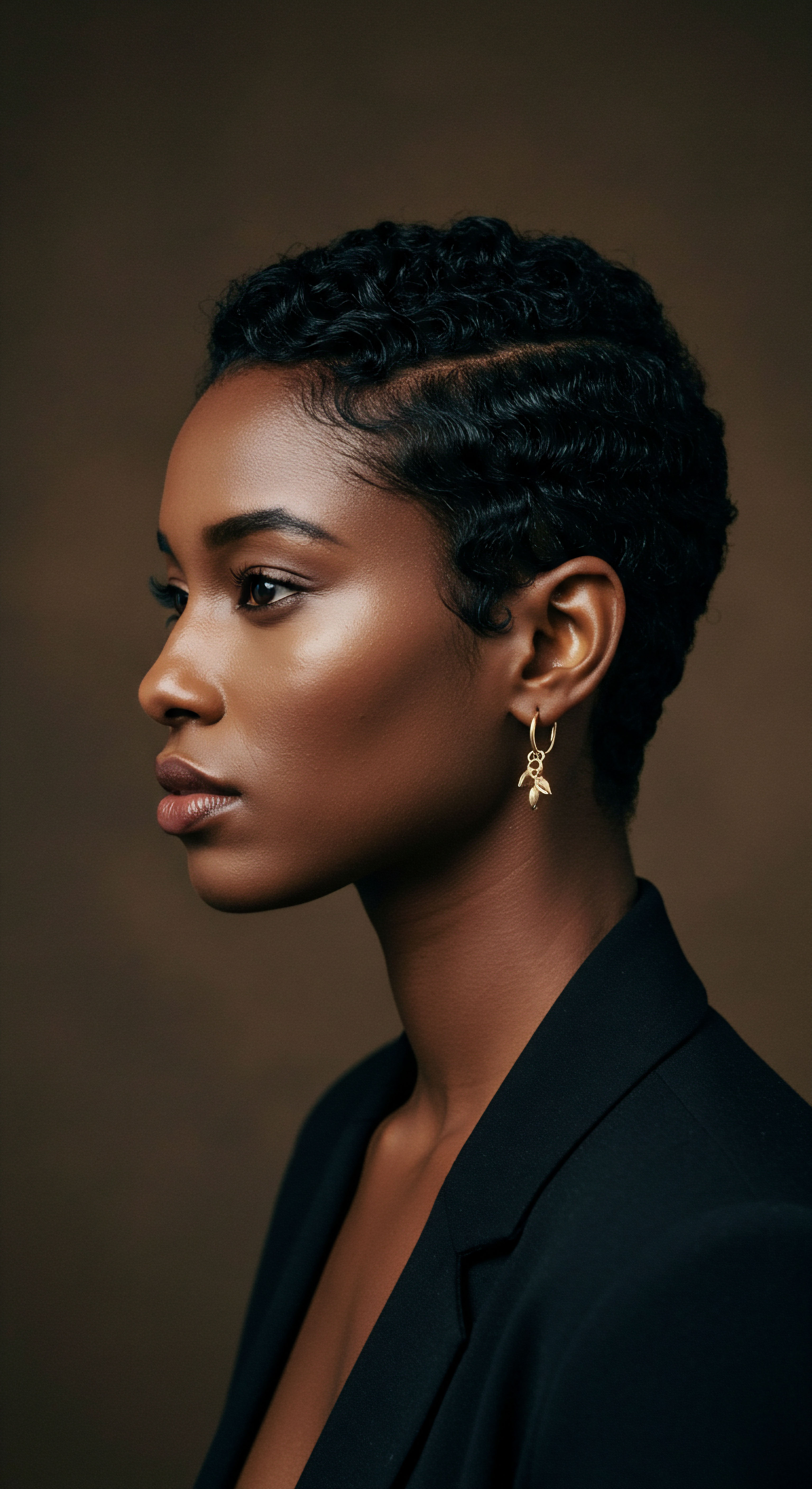
Roots
There exists a quiet conversation between our textured strands and the whispers of ancient wisdom, a dialogue often overlooked in the clamor of modern beauty. For those with coily hair, the quest for lasting moisture is not merely a preference; it is a fundamental pursuit, a daily tending to a unique crown. Our hair, with its remarkable spirals and tight bends, possesses a structure that demands a thoughtful approach to hydration, an approach deeply understood by generations who walked before us.
They turned to the earth’s abundant gifts, discovering elixirs that offered more than surface gloss. These were not just oils; they were traditions, passed down through time, each drop carrying a legacy of care and resilience.

Understanding Coily Hair Structure
Coily hair, often recognized as Type 4, exhibits a distinctive architecture that influences its moisture needs. The tight curl patterns, sometimes forming zig-zags or ‘o’ shapes, create a less visibly defined pattern compared to looser curls. This intricate structure means natural oils produced by the scalp, known as sebum, struggle to travel down the spiraled shaft from root to tip. As a result, coily strands tend to be naturally drier, often appearing to lack a certain luster and experiencing considerable shrinkage, sometimes up to 75% of their actual length.
The outermost layer of each hair strand, the cuticle, comprises overlapping scales. In coily hair, these cuticles can be slightly lifted or less compact due to the hair’s natural bends and curves, making it easier for moisture to escape. This inherent characteristic makes the deliberate addition of external moisture a vital component of coily hair care.
Coily hair’s unique structure, with its tight spirals, often hinders natural sebum distribution, making external moisture a fundamental requirement for health and vibrancy.
The delicate nature of coily hair, despite its robust appearance, also means it can be more prone to breakage if not properly hydrated. Each twist and turn represents a potential point of weakness, and when moisture levels dip, these points become more vulnerable. Proper moisture balance helps maintain the hair’s elasticity, allowing it to stretch and return without snapping. The goal, then, extends beyond merely adding water; it encompasses sealing that hydration within the hair shaft, creating a protective layer that helps the strands resist daily environmental stressors.

Why Moisture is a Constant Quest
The challenge of maintaining moisture in coily hair is a persistent one, stemming from both its physical characteristics and environmental interactions. The tightly coiled shape prevents sebum, the scalp’s natural conditioning oil, from easily moving down the hair strand. This leaves the mid-lengths and ends particularly susceptible to dryness.
When hair is dry, its outer cuticle layers can lift, making it even harder to hold onto water and easier for it to become brittle. This creates a cycle where moisture is absorbed quickly but also lost rapidly, leading to frizz and a feeling of constant thirst.
Consider the concept of hair porosity, which describes your hair’s ability to absorb and hold onto moisture. Coily hair can fall into various porosity categories, but often, due to styling practices or genetic predisposition, it may lean towards high porosity, where cuticles are more open, or low porosity, where they are tightly sealed. High porosity hair drinks in water and products with ease, yet loses them just as quickly, requiring heavier oils to create a lasting seal.
Low porosity hair, conversely, resists moisture absorption initially, with products sometimes sitting on the surface, but once hydrated, it retains moisture well. Understanding one’s own porosity is a crucial step in selecting oils that will truly serve the hair, rather than merely coat it.

Echoes of Antiquity Oils Through Time
The practice of using oils for hair care is not a recent discovery; it is a timeless tradition, a practice rooted deeply in human history across diverse cultures. From the sun-drenched lands of ancient Egypt to the vibrant civilizations of India and the rhythmic shores of the Caribbean, people recognized the profound benefits of natural oils for conditioning, protecting, and beautifying their hair. These early applications were not merely cosmetic; they were interwoven with wellness, spiritual practices, and the daily rhythms of life.
Ancient Egyptians, for instance, were meticulous in their hair care, utilizing ointments and oils to maintain groomed and healthy tresses. Similarly, Ayurvedic practices in India, dating back centuries, emphasized hair oiling as a foundational treatment, often performed at night or before washing, to protect strands from dry weather conditions and promote overall hair health. These traditions understood that oils provided a protective barrier, a film that could reduce transepidermal water loss from the scalp and hair, thereby reducing dryness.
They also recognized that certain oils could reduce the absorption of water into the hair, which helps to mitigate hygral stress – the damage caused by repeated swelling and shrinking of hair strands when wet and dry. This deep, inherited wisdom forms the bedrock of our understanding of ancient oils for coily hair moisture.

Ritual
Stepping from the quiet contemplation of hair’s foundational needs, we arrive at the practical artistry of daily care. This is where intention meets application, where ancient oils become tangible tools in the pursuit of vibrant, moisturized coily strands. It is a process that calls for gentle guidance, an exploration of techniques that honor both the wisdom of the past and the demands of contemporary life. The act of applying oil transforms from a simple step into a meaningful ritual, a moment of connection with one’s hair.

The Golden Elixirs A Closer Look
Among the vast array of natural oils, several ancient varieties stand out for their exceptional properties and historical application in hair care, particularly for coily textures. These oils possess unique molecular structures and fatty acid profiles that determine their ability to penetrate the hair shaft or to seal its outer layers, both vital for moisture retention.
- Coconut Oil ❉ A true stalwart, coconut oil has a small molecular size and is rich in lauric acid, a medium-chain fatty acid. This allows it to penetrate deeply into the hair shaft, bonding with hair proteins and reducing protein loss. Its ability to lessen water absorption also helps limit everyday hair damage.
- Olive Oil ❉ Known as ‘liquid gold’ in ancient Greece, olive oil is a powerful emollient. Its fatty acid composition, particularly oleic acid, creates a protective coating that reduces moisture loss and helps prevent breakage. While it doesn’t penetrate as deeply as coconut oil, it excels at surface conditioning and strengthening existing hair.
- Castor Oil ❉ This thick, viscous oil is rich in ricinoleic acid, a monounsaturated fatty acid. While scientific evidence for hair growth claims remains limited, it is a known humectant and moisturizer, helping to draw moisture into the hair and seal it. Its consistency makes it an excellent choice for sealing in hydration, especially for high porosity hair.
- Jojoba Oil ❉ Uniquely, jojoba oil is technically a liquid wax, closely resembling the natural sebum produced by our scalps. This similarity allows it to balance oil production, clean out hair follicles, and moisturize hair without weighing it down or causing buildup. It provides hydration and helps protect against breakage.
- Shea Butter ❉ While not an oil in the liquid sense, shea butter, derived from the shea tree nut, has been used for centuries for its moisturizing properties. Rich in fatty acids and vitamins, it works as a sealant, helping to lock moisture into the hair and alleviate dry scalp conditions. It creates a protective barrier of fatty acids, guarding against damage.

Application Techniques for Coily Strands
The manner in which these ancient oils are applied can greatly influence their effectiveness on coily hair. Simply pouring oil onto dry hair might lead to a greasy surface without true hydration. The key often lies in layering and warming the oil.
For optimal absorption, especially for low porosity hair where cuticles are tightly packed, warming the chosen oil slightly can make a considerable difference. Gentle warmth helps to slightly lift the cuticles, allowing the nourishing compounds to penetrate more deeply. This can be achieved by placing the oil bottle in a bowl of warm water or rubbing a small amount between your palms.
Applying oils to damp, rather than soaking wet or completely dry, hair is also highly recommended. The presence of water helps the cuticles remain slightly open, providing a better pathway for the oils to enter and seal in that hydration.
Warming ancient oils and applying them to damp, freshly hydrated coily hair can significantly improve their ability to penetrate and seal in moisture.
The “LOC” (Liquid, Oil, Cream) or “LCO” (Liquid, Cream, Oil) method is a widely recognized layering technique that works exceptionally well for coily hair. This method ensures that moisture is first introduced (liquid), then sealed in with an oil, and further locked with a cream or butter. For high porosity hair, which absorbs moisture quickly but loses it just as fast, applying oils to very wet hair immediately after a water-based product can help trap that initial hydration inside the hair shaft.

Crafting Your Oil Customization
The true artistry in using ancient oils for coily hair lies in customizing their application to suit individual hair needs and porosity. Not every oil serves the same purpose, and a thoughtful combination can yield superior results.
For those with Low Porosity Hair, lighter oils that readily penetrate are often preferred to avoid product buildup. Oils like Jojoba or Grapeseed Oil are excellent choices as they provide moisture without weighing the hair down. A pre-shampoo oil treatment, where a penetrating oil is applied before cleansing, can also be beneficial, helping to protect the hair from excessive water absorption during washing.
Conversely, High Porosity Hair, with its more open cuticles, often benefits from heavier oils that can effectively seal the hair shaft and prevent rapid moisture loss. Coconut Oil, despite its penetrating qualities, can also act as a strong sealant for high porosity hair due to its larger molecular structure compared to water, helping to form an effective barrier. Castor Oil and Shea Butter are also excellent choices for sealing in moisture on highly porous strands.
For those with Medium Porosity Hair, a balanced approach often works best, allowing for a variety of oils, from lighter to slightly heavier. Experimentation with different combinations can help discover the perfect blend for maintaining hydration and softness. The table below offers a general guide for selecting oils based on porosity, but individual results may vary, encouraging personal exploration.
| Oil Type Coconut Oil |
| Primary Action Penetrating, Sealing |
| Best Suited For High Porosity, Damaged Hair |
| Key Characteristic Small molecular size, Lauric acid |
| Oil Type Olive Oil |
| Primary Action Sealing, Conditioning |
| Best Suited For Medium to High Porosity |
| Key Characteristic Rich in Oleic Acid, Emollient |
| Oil Type Castor Oil |
| Primary Action Sealing, Humectant |
| Best Suited For High Porosity, Dry Scalp |
| Key Characteristic Thick consistency, Ricinoleic acid |
| Oil Type Jojoba Oil |
| Primary Action Balancing, Penetrating |
| Best Suited For Low Porosity, Oily Scalp |
| Key Characteristic Mimics natural sebum, Liquid wax |
| Oil Type Shea Butter |
| Primary Action Sealing, Moisturizing |
| Best Suited For High Porosity, Very Dry Hair |
| Key Characteristic Thick butter, Rich in fatty acids |
| Oil Type Selecting oils based on hair porosity can significantly enhance moisture retention and overall hair well-being. |

Relay
As we deepen our conversation about ancient oils and coily hair moisture, we move beyond surface-level application to the profound interplay of science, cultural heritage, and personal connection. What deeper truths lie within these traditional practices, and how do they speak to the very structure of our strands? The answers reside not just in the visible sheen, but in the molecular dance within each coil, a dance supported by both ancestral wisdom and modern scientific inquiry. This section unearths the complexities, drawing upon research to illuminate the why behind these time-honored customs.

Beyond the Surface Oil Science Unveiled
The effectiveness of an oil on coily hair is not solely about its historical pedigree; it is deeply rooted in its chemical composition, specifically its fatty acid profile and molecular structure. Oils are composed of triglycerides, which are essentially a glycerol backbone with three fatty acid molecules attached. The length and saturation of these fatty acid chains dictate how well an oil can interact with and penetrate the hair shaft.
Saturated and monounsaturated fatty acids, typically possessing shorter or more compact molecular structures, tend to penetrate the hair fiber more effectively. This is because their smaller size allows them to slip through the cuticle layers and into the hair’s cortex. Coconut oil, with its abundance of lauric acid (a medium-chain saturated fatty acid), is a prime example of an oil with superior penetrating ability. Its affinity for hair proteins also aids this process.
Conversely, polyunsaturated oils, with their larger and more branched molecular structures, tend to remain on the hair’s surface, acting more as sealants than penetrants. This understanding helps explain why certain oils are better for internal conditioning while others excel at external protection.
Consider the concept of hydrophobicity, the property of repelling water. When penetrating oils are absorbed into the hair shaft, they can make the hair more hydrophobic, meaning it becomes more resistant to water absorption. This is beneficial because excessive water absorption can lead to hygral fatigue, a cycle of swelling and shrinking that weakens the hair strand over time.
A study on bleached hair, for example, found that medium-chain fatty acids like caprylic acid (C8:0) and capric acid (C10:0) showed the highest penetration, contributing to protein retention and strength recovery. This scientific backing reinforces the long-held belief in the protective qualities of certain ancient oils.

A Heritage of Hydration Cultural Perspectives
The use of ancient oils for coily hair is not just a matter of chemistry; it is a profound cultural statement, a continuation of practices that speak to identity, resilience, and beauty. Across Africa, the Caribbean, and the diaspora, the application of natural oils and butters has been central to hair care rituals for generations. These practices often extend beyond simple conditioning, serving as moments of intergenerational connection, self-care, and cultural affirmation.
In many West African communities, shea butter, known as “karite tree” or “tree of life,” has been harvested and utilized for millennia not only for its moisturizing properties but also for its medicinal and protective qualities. Its application to hair and skin is deeply rooted in tradition, symbolizing health and vitality. Similarly, in India, Ayurvedic practices have long prescribed specific oiling rituals, recognizing the link between scalp health, hair strength, and overall well-being. These traditions often involve warming the oil and massaging it into the scalp, a practice believed to stimulate circulation and promote healthy growth.
These historical uses underscore a nuanced understanding of hair needs that predates modern cosmetic science. Ancestors instinctively grasped that coily hair, due to its structural characteristics, required consistent moisture and protective barriers. The oils they selected were those readily available in their environments, often chosen through generations of empirical observation for their efficacy in sealing moisture, adding luster, and providing a soft feel. This cultural continuity is a testament to the enduring power of these ancient remedies.

The Science of Strand Strength Data Points
While anecdotal accounts often highlight the benefits of ancient oils, scientific research continues to provide valuable insights into their mechanisms of action. One area of particular interest is how certain oils influence hair protein loss and overall strand integrity.
A notable study comparing the impact of various oils on hair found that Coconut Oil, due to its unique molecular structure, is superior in preventing protein loss from hair, both virgin and damaged. This effect is attributed to its primary fatty acid, lauric acid, which can penetrate the hair shaft and interact with the hair’s keratin proteins. This finding is particularly significant for coily hair, which can be prone to dryness and protein loss due to its delicate structure and frequent manipulation. The study suggests that using coconut oil as a pre-wash treatment or a leave-in conditioner can help mitigate the protein depletion that often leads to weakened strands and breakage.
Scientific inquiry reveals that coconut oil, with its unique lauric acid content, stands out in its capacity to reduce protein loss in hair, a vital benefit for maintaining the integrity of coily strands.
Another compelling data point relates to the anti-inflammatory properties of certain ancient oils and butters, which can impact scalp health and, by extension, hair growth. Research has identified specific compounds in Shea Butter, such as triterpene cinnamates and triterpene acetates, which possess anti-inflammatory qualities. While direct human studies on shea butter’s impact on hair growth related to inflammation are still developing, some types of hair loss are indeed associated with scalp inflammation.
The ability of shea butter to alleviate inflammatory concerns affecting hair follicles suggests a potential supportive role in creating a healthier environment for hair growth. This demonstrates a fascinating intersection of traditional knowledge and emerging scientific understanding, where ancient remedies hold keys to modern hair wellness challenges.
Furthermore, the debate surrounding oils and hair growth continues. While some oils like castor oil are popularly associated with growth, scientific evidence remains limited. For instance, while castor oil contains ricinoleic acid, which may have some effects on hair, conclusive human clinical research directly supporting its ability to stimulate hair growth is not yet robust.
This distinction between traditional belief and confirmed scientific efficacy is an important one, allowing individuals to make informed choices about their hair care regimens, prioritizing proven benefits like moisture retention and protection over unverified claims. The focus for coily hair remains primarily on oils that demonstrably hydrate, seal, and strengthen the hair shaft, rather than those promising rapid growth without substantial backing.

Reflection
Our exploration into the ancient oils for coily hair moisture has traversed historical pathways, delved into the intricacies of hair science, and paused to appreciate the enduring wisdom of cultural practices. We have seen that the journey to moisturized, resilient coily strands is not a singular path but a rich landscape of understanding. From the foundational knowledge of hair structure to the deliberate application of oils, and the deeper scientific and cultural currents that shape our choices, each layer adds depth to our appreciation.
The answers are not always simple, nor are they static; they invite a continuous conversation between inherited knowledge, personal experience, and the ever-unfolding discoveries of science. May your own path with your hair be one of gentle inquiry and profound connection.

References
- 1. Kumar, K. A. & Badruddeen, S. (2022). Hair Oils ❉ Indigenous Knowledge Revisited. Journal of Pharmacy & Bioallied Sciences, 14(Suppl 1), S37-S42.
- 2. Rele, J. S. & Mohile, R. B. (2003). Effect of mineral oil, sunflower oil, and coconut oil on prevention of hair damage. Journal of Cosmetic Science, 54(2), 175-192.
- 3. Gavazzoni Dias, M. F. R. (2015). Hair Cosmetics ❉ An Overview. International Journal of Trichology, 7(1), 2-15.
- 4. Gode, V. & Das, S. (2018). Natural oils and hair care ❉ a comprehensive review. Journal of Pharmacognosy and Phytochemistry, 7(3), 1690-1695.
- 5. Ruetsch, S. B. et al. (2001). The effect of olive oil on the mechanical properties of human hair. Journal of Cosmetic Science, 52(4), 229-242.
- 6. Al-Sayed, E. & Al-Qurainy, F. (2020). Jojoba oil ❉ An updated review. Journal of Medicinal Plants Research, 14(20), 570-580.
- 7. Al-Snafi, A. E. (2016). The medical importance of Ricinus communis (castor oil plant) ❉ A review. IOSR Journal of Pharmacy, 6(6), 62-79.
- 8. Dweck, A. C. (2007). The use of natural ingredients in hair care products. International Journal of Cosmetic Science, 29(4), 261-282.
- 9. Gediya, S. K. et al. (2011). Herbal plants ❉ A source for hair growth. Pharmacognosy Reviews, 5(9), 10-21.
- 10. Kumar, A. & Sharma, M. (2018). Role of traditional Indian herbs in hair care. Journal of Pharmacognosy and Phytochemistry, 7(5), 1803-1808.
- 11. Fiume, M. M. et al. (2015). Safety Assessment of Simmondsia Chinensis (Jojoba) Seed Oil and Hydrogenated Jojoba Oil as Used in Cosmetics. International Journal of Toxicology, 34(1_suppl), 44S-59S.
- 12. Akihisa, T. et al. (2010). Triterpene alcohols and fatty acids from shea (Butyrospermum parkii) butter. Journal of Oleo Science, 59(12), 629-634.